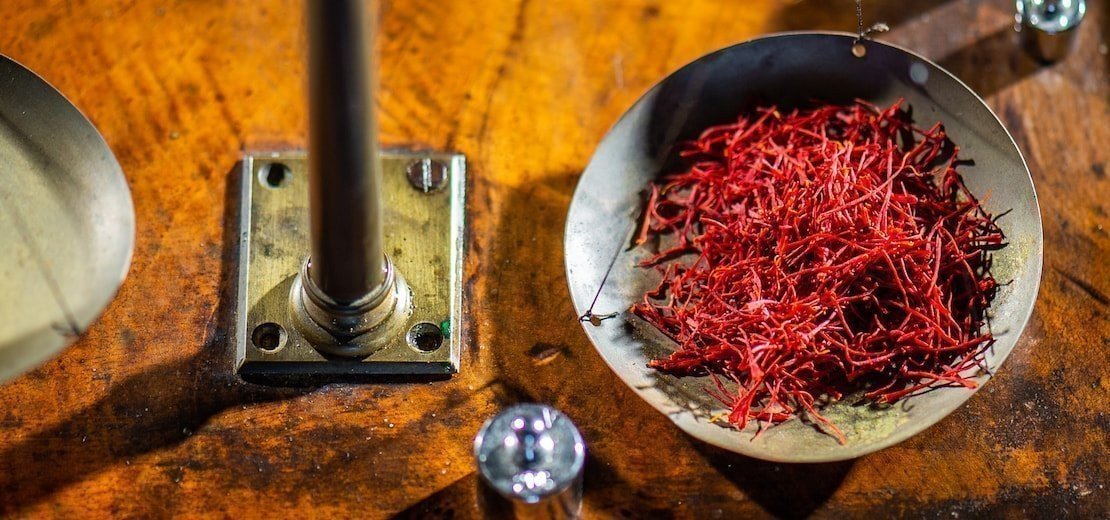Saffrons

-
-

Taliouine Saffron (Morocco)
- €13.50
-

Saffron from Mont-Saint-Michel Bay
- €17.10
-

Quercy Saffron
- €17.10
-

Alpes Saffron
- €17.10
-

Morocco Saffron
- €11.20
-

Saffron from Iran
- €11.20
-
 SafransFor thousands of years, “red gold” has been a precious, much sought-after spice. It comes from the saffron crocus Crocus sativus, and the name is derived from the Latin word ‘safranum’ whose root is the Arab term for the spice, zaʿfarān.” Saffron refers to the three red stigmata found in the heart of this mysterious, violet-petaled crocus flower.The member of the Iridacae family is a bulb plant native to Asia Minor. Both saffron bulbs and their cultivation were introduced to France in the 11th century. By the 19th century, France was producing 30 tons of saffron each year. Saffron cultivation disappeared from France at the beginning of the 20th century, before being quietly reinstated in the 1990’s Small saffron operations are now spread out all over France and can be found in the Loiret, Lot (Quercy saffron), Creuse, Brittany, and Alps regions.
SafransFor thousands of years, “red gold” has been a precious, much sought-after spice. It comes from the saffron crocus Crocus sativus, and the name is derived from the Latin word ‘safranum’ whose root is the Arab term for the spice, zaʿfarān.” Saffron refers to the three red stigmata found in the heart of this mysterious, violet-petaled crocus flower.The member of the Iridacae family is a bulb plant native to Asia Minor. Both saffron bulbs and their cultivation were introduced to France in the 11th century. By the 19th century, France was producing 30 tons of saffron each year. Saffron cultivation disappeared from France at the beginning of the 20th century, before being quietly reinstated in the 1990’s Small saffron operations are now spread out all over France and can be found in the Loiret, Lot (Quercy saffron), Creuse, Brittany, and Alps regions.Saffron is grown in temperate, variable climates. The most important factor for it to thrive is a sharp difference between daytime and nighttime temperatures that produce a thermal shock. Iran, Greece, Afghanistan, Morocco, and India are the major producers.
Both the harvest of saffron flowers and the production of the spice are complex processes with a very low yield—which explains the spice’s high price. The blossoms are hand-gathered when the sun first comes up on the day the buds flower. Flowering occurs only for ten to twelve days, once a year. Harvesting must take place quickly and is labor-intensive. The harvest is also highly perishable because warm temperatures will wilt the just-opened blossoms. The petals are plucked from each flower the day they are harvested, then the stigmas are dried and aged.
Saffron was known to the Egyptians and is the source of many ancient Greek legends. During the Renaissance, saffron was reputed to cure tuberculosis, sore throats, and liver ailments. Generally speaking, saffron was considered an extremely refined, sophisticated spice and was used extensively in medical remedies, perfumes, fabric-making and cooking. Even today, saffron remains a precious gift to those who receive it.
The stamen color varies from yellow-orange to deep crimson. The stamens with darker hues are often those with the most flavor. Saffron’s distinctive, deep, warming flavor has traditionally been paired with seafood (during Lent). It can also add an intriguing note to fruit desserts with apples, pears, and especially quinces. Saffron goes particularly well with rice, bouillons, beans, and stewed meat and vegetables. It can also be savored infused in a cup of black tea or warm milk.
-

Saffron from Spain
- €19.95
-